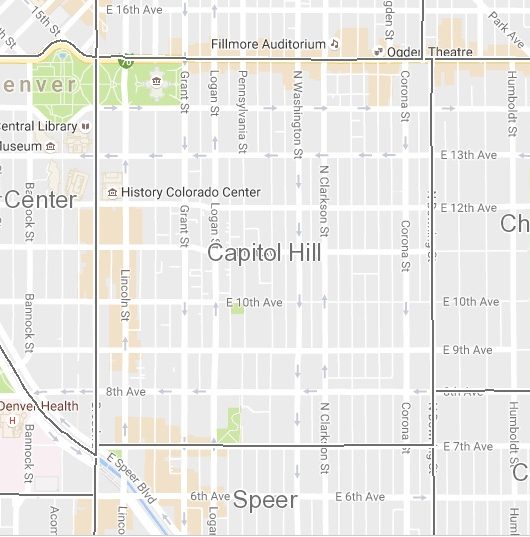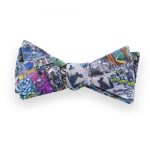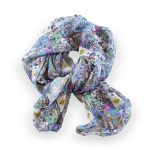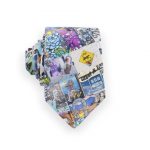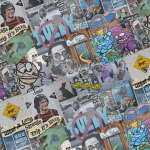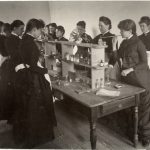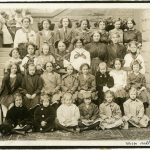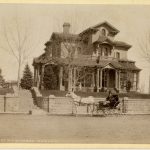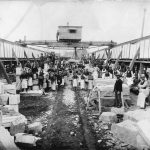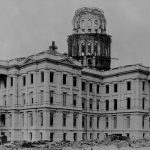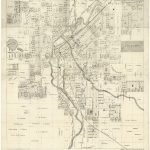“I don’t think you can get any more centrally located than Cap Hill. I park my car on Friday and I very rarely turn it on before Monday. You’ve got the whole package here, there are singles and families; there are so many places you can walk to and there are so many events going on all the time.” -Tim Vargo, Cap Hill neighbor
Layered with history, classic architecture, a vibrant music scene, street art, city grit and stickers, Denver’s Capitol Hill is considered by many to be the city’s most urban neighborhood. It’s centrally located near the Capitol (its namesake) and offers easy walkable access to the numerous cultural venues near Civic Center Park, plus an abundance of restaurants, bars, music venues, small shops and mass transit hubs. It’s easy to see why this neighborhood is so popular and why rents for its unique, quirky and historic apartments are on the rise. But how did this neighborhood get its start, who used to live here and what do current residents love about Cap Hill?
A Brief History of the Capitol Hill Neighborhood
By Laura Ruttum Senturia
Library Director, Stephen H. Hart Library at History Colorado
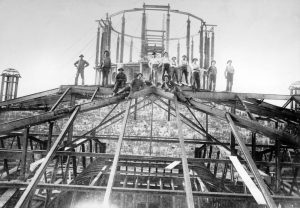
Workers pose for a photo as the dome of the Colorado Capitol starts to take shape. Image courtesy Stephen H. Hart Library & Research Center, History Colorado.
Once called “Brown’s Bluff,” the now densely-populated neighborhood of Capitol Hill originally began as a homestead claim belonging to one man, H.C. Brown. Businessman and eventual real estate magnate Henry Cordes Brown (also the man responsible for the Brown Palace) laid claim to the area now known as Capitol Hill, and built a cabin at 12th and Sherman in 1864. The area was poor for farming, and 1.5 miles from the city of Denver (located at what is now Larimer, Market, etc.). The sparsely-populated “Brown’s Bluff” stood with just that one building until 1867, when one additional house was built. In 1868, in an attempt to increase the worth of his property on the hill, H.C. Brown donated land to the state for a new Colorado Capitol building. Real estate prices picked up significantly as the capitol building began to take shape, and the neighborhood began to feature houses of the wealthy, leading to the neighborhood’s second name: Quality Hill. The cornerstone of the capitol building was laid on July 4, 1890, construction commenced, lawmakers moved in circa 1895, and the final touch of the gold dome was completed in 1908. With the completion of the capitol, it was no time until the neighborhood took on its current name, “Capitol Hill.”
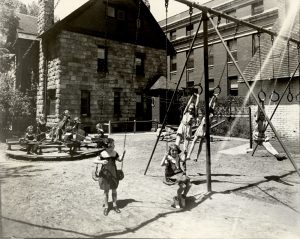
Children playing at St. Mary’s Academy, the state’s oldest continuously operating pre-collegiate school, which was founded in 1864. The school was located at 14th & Pennsylvania from 1911 until the early 1950s. Image courtesy Stephen H. Hart Research Center, History Colorado.
Residents of Quality/Capitol Hill over the years included millionaires such as the Tabors (Horace, Baby Doe and Augusta all lived there), politicians such as Mayor Robert Speer, mine owners (& Titanic survivor!) James and Molly Brown, and publishers such as Frederick G. Bonfils (greatly expanded the Denver Post). Some of the early institutions in the neighborhood included Wolfe Hall, a grand school that was located where Morey Middle School sits today, the original St. Mary’s Academy school, and the cemetery that was eventually (partially) moved to make room for Cheesman and Congress Parks and the Botanical Gardens.
How did this once mostly wealthy neighborhood change into the decidedly less exclusive, but more vibrant, demographically younger, and apartment building-covered area we know today? Economic depressions, and surprisingly, the automobile had a lot to do with it.
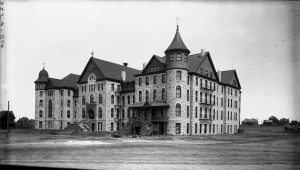
Wolfe Hall (13th & Clarkson) was a private Episcopalian school that opened in 1889 and was torn down in 1920. Circa 1900. Image courtesy Stephen H. Hart Library & Research Center, History Colorado.
The first gradual step towards change was the silver panic crash of 1893, when many of the mining barons lost fortunes. With the resulting depression in Denver, fewer people were able to afford such large homes or lots, and eventually lot sizes were adjusted. Smaller family homes were built between the mansions. As the character of the neighborhood adapted, and the city continued to grow eastward, Capitol Hill shifted towards a more middle class aesthetic. Developers began putting up apartment buildings (still for more comfortable families, if not quite so wealthy as before). In the 1920s, the invention of the automobile turned Colfax from a sleepy residential street into a commercial strip, connecting downtown Denver with the ever-expanding city. The Great Depression of the 1930s suppressed rents and delayed many improvements to buildings citywide. During this time the wealthy largely decamped to new, fancier suburbs, or lost their wealth entirely. Many private homes subdivided into smaller apartments during this era, and during the apartment shortage in quickly-growing Denver following World War II.
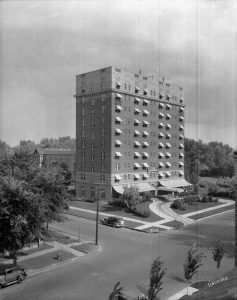
The Colburn Hotel (10th & Grant) opened in 1928 and although lawmakers, foreign dignitaries and stars of the stage all stayed there, its most noted visitors were Neal Cassady and Allen Ginsberg, who spent time at the hotel in 1947. It is said that they, along with Jack Kerouac, frequented the hotel’s bar. Image courtesy Stephen H. Hart Library & Research Center, History Colorado.
By the 1950s, much of the housing stock in the area was shabby, and the neighborhood had lost the “quality” aspect of its previous name. By this point, the region took on a new identity, as the place where the original hipsters lived and played, these being the Beatniks memorialized in works such as Jack Kerouac’s On the Road. In fact, Jack’s real-life friend Neal Cassady, memorialized as Dean Moriarty in the book, was known to hang around the Colburn Hotel at 10th and Grant. His eventual wife, Carolyn Robinson, lived there while she was a DU grad student in the late 1940s, and in her autobiography mentions “meeting the guys downstairs in the bar” (the infamous Charlie Brown’s).
By this point in history, the bars, low-rent shops, and illegal “business activities” occurring along Colfax, seen as a perk by the Beats, became a downward drag on the property values of the neighborhood. Colfax would continue to be a challenge for the area for decades to come.
Capitol Hill struggled through the 1970s, 80s, and 90s, but as one often sees during periods of economic stagnation, the period was a pretty rich one for underdog culture. With the opening of Wax Trax records at 13th and Washington in 1975, the rock and punk music scenes had a new home base around which to coalesce. Capitol Hill denizens turned their grubby environment into a strength, and created an incredibly rich and creative underground culture served by the music shop, nearby clothing stores Fashion Nation and Imi Jimi, run-down concert venues on Colfax, and various bars and clubs.
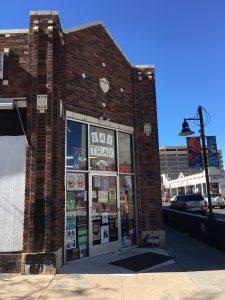
Wax Trax at 13th & Washington, 2016. Image courtesy Tara Bardeen
Astronomical population growth statewide starting in the early 2000s pumped new life, and money, into the area. The district’s geographic proximity to downtown and new “places to be seen,” paired with affordable apartment rents (well, at least until the past few years), made the neighborhood a popular landing place for new transplants and younger people just starting out on their own. Call this the Hipster 2.0 revitalization of the neighborhood. This formula—younger residents, culture, and new money pouring in—has lifted Capitol Hill’s fortunes and changed its face once again. The area is still popular with the young and artistic, but rising rents are beginning to reshape it once again.
So that’s Capitol Hill is a nutshell: from a barren bluff, to a bedroom community for the wealthy and well-connected, and then to the neighborhood where the artists and counter-culture live and play (through decades of their various iterations). With its current buzzing, energetic character, where will it go next?
Wrap Cap Hill Around Your Neck and Take It Everywhere
“Capitol Hill was once the home to Denver’s most elite. Today, it is now Denver’s most densely populated neighborhood, full of music, art, and grunge. For this design, I wanted to capture just that: the street art of Cap Hill. This design not only depicts the creativity of Cap Hill, but the style and character which I love so dearly. Cheers to you, Cap Hill, for being the most unique and beautiful neighborhood in Denver.” – Allison, designer at Knotty Tie Co.
Get your own Cap Hill-inspired bowtie, necktie or scarf here: Knotty Tie Co.
Save 20% on your order with code GOPLAYDENVER.
Interview with a Neighbor: Tim Vargo (1300 block of Ogden)
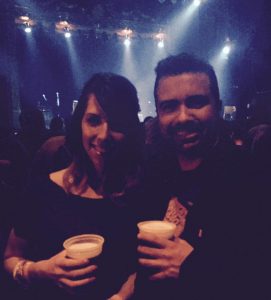
Tim Vargo and girlfriend Amber at a Gogol Bordello show at The Ogden. Image courtesy Tim Vargo
How long have you lived in Capitol Hill?
I’ve been coming to Cap Hill since I was a teen. My friends and I would drive to Cap Hill from Arvada to shop at Wax Trax, Imi Jimi and Fashion Nation and go to shows at the Fillmore, the Ogden and the Bluebird.
I lived in Baker for a while and near City Park and then I moved to L.A. for about 2 years. When I moved back to Colorado, I had been laid off from my job, so I stayed at my parents house for about 6 months and I was just combing Cap Hill all the time trying to find that perfect place and I found it at the Cornwall. That building is beautiful; it’s historic… I’ve been living in that building for the last 7 years and Amber moved in a couple of years ago.
What drew you to this neighborhood?
I’ve always really enjoyed the music scene, so again, when I was younger, I would go to Cap Hill for the music shopping, the bars, restaurants and concerts. I would go to shows at The Ogden all the time.
One of the main draws is all the culture down here and that you can walk anywhere too. I can walk to the Fillmore, I can walk to The Ogden, and to any of the stores we want go to. We can walk to restaurants, little coffee shops and to Cheesman Park.
How would you describe Capitol Hill in 3-5 adjectives?
Artistic, historic, eclectic and urban.
How would you spend a perfect day in Cap Hill?
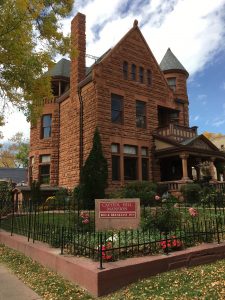
I suppose we might also start with breakfast at City O’ City because we love it there too. Jelly is also good. We’re big walkers, so we would head right down to the central library, the Art Museum, History Colorado or Civic Center Park – there’s always something going on down there.
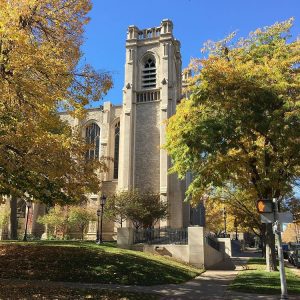
St. John’s Cathedral (13th & Washington) hosts regular music concerts that are free and open to the public. Image courtesy Tara Bardeen.
For dinner, we probably would go to Angelo’s (6th & Washington); it’s our favorite place. Mussel Mondays are amazing. Our late night would include dancing at Pearl’s and then getting pizza at Benny Blanco’s. If it were our perfect day, it would be Lipgloss night at Pearl’s.
What might surprise people about your neighborhood?
It’s safer than people might think it would be given how many people are here and how urban it is. It’s a lot more family-friendly than people might think. You can actually raise kids here.
What are some of the community hubs of your neighborhood?
Whole Foods (11th & Ogden) and the King Soopers (9th and Downing), and also Cheesman Park. Our building is also our tiny community. We know our neighbors really well. I bet a lot of the people who live in all the apartment buildings in this neighborhood feel that way.
What are your favorite places to walk?
We like walking on 7th Ave. and in Cheesman Park and I like walking by Morey Middle school and St. John’s Cathedral when I walk our dog.
Live in Cap Hill? We’d love to know what your perfect day would include!
More Historical Photos We Think You’ll Enjoy
If you want to see even more, just head down to the Stephen H. Hart Library & Research Center at History Colorado (12th & Broadway). You don’t need an appointment, just walk in. It’s free and the librarians are friendly and helpful! You can also check out some of their collection online: h-co.org/collections
- Students in a chemistry class at Wolfe Hall (13th & Clarkson).
- Students at Wolfe Hall circa 1900.
- The residence of H.A.W. Tabor, 1898.
- Workers shaping marble for the Colorado Capitol.
- Colorado Capitol under construction.
- Map of Denver from 1882.
Images: All images, unless otherwise noted, are courtesy Stephen H. Hart Library & Research Center, History Colorado.
Sources: “Denver’s Capitol Hill,” by Phil Goldstein; “Off the road : my years with Cassady, Kerouac, and Ginsberg,” by Carolyn Cassidy; “Denvoid and the Cowtown Punks: A Collection of Stories from the 80s Denver Punk Scene,” by Bob Rob Medina
